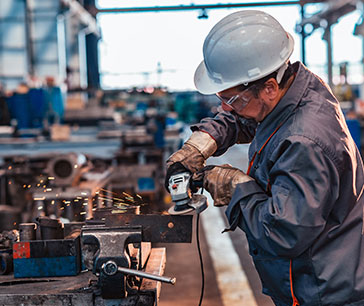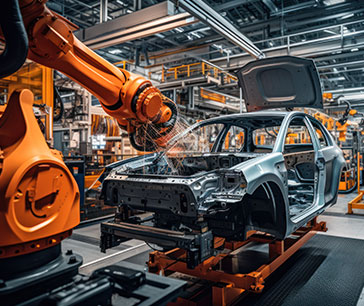Table Of Contents
- Technological Advancements: Exploring New Realms in Manufacturing Innovation
- Navigating the Next Phase of Change
- Workforce and Labor Trends 2024
- Sustainability and Environmental Responsibility
- Shifting Paradigms: Embracing a Circular Economy in the Manufacturing Sector
- Market Momentum: Unraveling the Dynamics of Manufacturing Evolution
- Emerging Technologies and Innovations to Watch in 2024
- Economic and Industry Trends
- Navigating 2024: Predictions for Manufacturing Trends
- Challenges and Risks in Manufacturing Industry 2024
- Future Perspectives in Manufacturing: A Triad of Imperatives
- The Bottom Line

Sonia Mutreja

Pooja Parvatkar
Manufacturing Sector in 2024: Steering a Technological and Sustainable Future

In 2023, the manufacturing industry continued to surpass the expectations despite facing supply headwinds, labor shortages, and an uncertain economic environment. Manufacturers had increased their digital investment and had accelerated the adoption of emerging technologies.
As we approach 2024, the manufacturing sector is on the brink of significant transformations. Technological advancements, changing workforce dynamics, sustainability initiatives, and global market shifts are set to shape the industry’s landscape. This industry brief by Allied Market Research explores the anticipated trends and changes in manufacturing for 2024, focusing on technology, workforce dynamics, sustainability, and global market shifts.
Technological Advancements: Exploring New Realms in Manufacturing Innovation
In 2024, technology is set to play a crucial role in aiding manufacturers as they confront various challenges. Amid a persistent drive for efficiency and a focus on enhancing resilience across organizations, many manufacturers are committed to advancing their digital transformation goals. The sector is expected to undergo a profound transformation fueled by advanced technologies that are not only enhancing efficiency and reducing errors but also introducing a new era of intelligent and adaptable machines capable of intricate tasks.
Expansion of Automation and Robotics
Automation and robotics will continue to revolutionize manufacturing floors in 2024. These technologies enhance efficiency, reduce errors, and improve productivity. With advancements in robotics, machines are becoming more intelligent and adaptable, capable of performing complex tasks with precision. The global industrial robotics market is anticipated to generate a revenue of $163 billion by 2032.
Rise of Additive Manufacturing (3D Printing)
Additive manufacturing, also known as 3D printing, will gain increasing importance in 2024. This technology enables customization, waste reduction, and production flexibility. It offers significant advantages for creating complex pieces and prototyping products, revolutionizing traditional manufacturing methods. The 3D printing industry is expected to witness notable growth in 2024 owing to a reduction in manufacturing cost and process downtime.
Integration of the Internet of Things (IoT)

The internet of things (IoT) is transforming manufacturing by enabling machines to communicate with central control systems and each other. Real-time monitoring and predictive maintenance facilitated by IoT can significantly reduce downtime and enhance productivity in smart factories. The global IoT in manufacturing market is projected to reach $1,495.65 billion by 2030.
Navigating the Next Phase of Change
The global manufacturing landscape, influenced by technological advancements, climate change, and geopolitical tensions, has undergone a significant transformation. Looking ahead to 2024, five key trends are poised to shape the manufacturing sector.
Digital Tools for Optimization
- Utilization of cloud computing and automation for real-time insights
- Targeted adoption of digital tools to address specific production challenges
- Streamlining product changeovers, limiting manual data entry, and optimizing quality control
Automation for Manufacturing Resilience
- Increased reliance on automation tools for operational resilience
- Mitigation of labor shortages, redeployment of workers, and reduction of running costs
- Strategic investment in automation to prepare for economic uncertainties and potential recessions
Scalability and Sustainability through Collaboration
- Emphasis on collaboration for sustainable growth and progress
- Coordinated efforts across stakeholders to address economic, social, and environmental challenges
- Examples include collaborative efforts in developing sustainable packaging solutions for reduced environmental impact
Human-Automation Interaction
- Anticipation of increased interaction between human workers and digital tools
- AI-enabling workers to focus on meaningful and high-value activities
- Positive impact of human-robot collaborations on productivity
Predictive Mindset Approach
- Shift from traditional ‘break and fix’ service model to predictive uptime monitoring
- Development of a new breed of data-driven service engineers
- Integration of remote consultative capabilities and data analytics into technical knowledge
Workforce and Labor Trends 2024
The manufacturing workforce is adapting to new roles, skill requirements, and collaborative models. This evolution is reshaping traditional manufacturing practices and fostering innovation. From the integration of automation to the demand for diverse skill sets, workforce dynamics play a crucial role in defining the industry’s trajectory.

Skill Development and Training
As technology advances, the demand for skilled workers who can operate and maintain cutting-edge machinery is rising. Manufacturers will invest more in training programs to upskill their employees and enable them to collaborate effectively with robotics and automated systems.
Embracing Remote and Flexible Work Arrangements
Manufacturing is exploring remote and flexible work arrangements, particularly in design, administration, and certain aspects of production planning. Digital tools enable increased flexibility in these roles while maintaining the predominantly onsite nature of manufacturing jobs.
Sustainability and Environmental Responsibility
In the dynamic landscape of the manufacturing sector, the spotlight is increasingly turning towards sustainability and environmental responsibility. Industries recognize their pivotal role in the global environmental equation. From resource-efficient processes to eco-friendly innovations, manufacturers are embracing practices that harmonize industrial growth with environmental preservation.
Supply Chain Sustainability
The traditional linear model of supply chains is evolving into a circular and sustainable framework. Manufacturers are recognizing the need to incorporate eco-friendly practices throughout the supply chain. Adopting sustainable sourcing, ethical labor practices, and reduced waste generation are becoming imperative. Manufacturers are increasingly adopting circular supply chains, emphasizing recycling, refurbishing, and reusing materials. This will minimize environmental impact and foster a more resilient and cost-effective supply chain.
Green Logistics
Green logistics involves optimizing transportation and distribution processes to minimize environmental impact. This approach is gaining traction as manufacturers seek to reduce their carbon footprint in the delivery of goods. Manufacturers are transitioning towards more sustainable transportation modes, such as electric or hybrid vehicles and fuel-efficient shipping options. This is expected to reduce emissions and contribute to long-term cost savings. Besides, leveraging technology is a key enabler of green logistics. Advanced analytics and route optimization software help streamline transportation routes, reducing fuel consumption and emissions in 2024.
Carbon Footprint Reduction
Reducing carbon footprint is at the forefront of manufacturing sustainability goals. This involves minimizing greenhouse gas emissions across the entire production process. Manufacturers are investing in energy-efficient technologies and practices to minimize energy consumption during production. This includes the use of energy-efficient machinery, optimized production schedules, and the adoption of Industry 4.0 technologies. Minimizing waste generation and promoting recycling are integral to carbon footprint reduction. Manufacturers are implementing waste reduction strategies, such as lean manufacturing principles, and developing innovative ways to recycle and repurpose waste materials.
Focus on Sustainable Manufacturing Practices
Sustainable manufacturing practices will take center stage in 2024. Manufacturers will actively reduce waste, optimize energy consumption, and incorporate recycled materials. Lifecycle assessments will be used to understand and minimize the environmental impact of products.

Shifting Paradigms: Embracing a Circular Economy in the Manufacturing Sector
In the manufacturing sector, the traditional linear economy model is giving way to a more sustainable and environmentally conscious approach – the circular economy. This shift in 2024 will reflect a growing awareness of the environmental impact of industrial activities and the need for a more responsible and resilient manufacturing framework.
Challenges of the Linear Economy in Manufacturing
- Resource Depletion: The linear model heavily relies on finite resources, depleting them at an unsustainable rate. This not only threatens the availability of essential materials but also contributes to environmental degradation.
- Waste Generation: The disposal of end-of-life products and manufacturing waste in landfills is a major drawback of the linear economy. This creates environmental hazards and represents a loss of valuable resources that could potentially be reclaimed.
- Environmental Impact: From carbon emissions during production to the energy-intensive extraction of raw materials, the linear economy significantly contributes to climate change and other environmental issues.
Advantages of a Circular Economy in Manufacturing
- Resource Efficiency: By prioritizing the extension of product lifecycles through repair, refurbishment, and remanufacturing, a circular economy conserves resources and reduces the demand for new raw materials.
- Waste Reduction: Circular economy practices focus on minimizing waste by reusing materials and components. This reduces the environmental footprint and addresses the growing problem of landfill overcrowding. The global waste management market is projected to grow at a CAGR of 5.5% from 2023 to 2032.
- Cost Savings: Adopting circular economy principles can lead to significant cost savings in the long run. Efficient resource use, reduced waste disposal expenses, and the potential for new revenue streams from recycled materials contribute to economic sustainability.
- Environmental Stewardship: Embracing a circular economy aligns with broader environmental goals, contributing to biodiversity preservation, climate change mitigation, and overall ecosystem health.
Market Momentum: Unraveling the Dynamics of Manufacturing Evolution
In 2024, the manufacturing sector is expected to stand at the intersection of dynamic market forces and relentless globalization, shaping its trajectory in unprecedented ways. From supply chain intricacies to disruptive innovations, the complex tapestry defines the sector’s present and shaping its future in an interconnected world.
- Shifting Global Supply Chains
Manufacturers will diversify their supply chains in response to lessons learned from global disruptions. Balancing efficiency with resilience, companies will incorporate more regional sourcing and production, reducing risks associated with long supply chains. - Increasing Customization and Consumer Demand
Consumer demand for customized products will drive manufacturing processes. Manufacturers will adapt to offer more personalized options, requiring flexible production systems and innovative design approaches. - Economic and Trade Policy Influences
Economic policies and trade agreements will continue to shape the manufacturing landscape in 2024. Manufacturers must remain agile and adaptable to navigate changing conditions and leverage new market opportunities.
Emerging Technologies and Innovations to Watch in 2024
Proliferation of Artificial Intelligence (AI)
Manufacturing processes will see deeper integration of AI, enabling improved decision-making, streamlined production operations, and enhanced quality control. AI's predictive maintenance capabilities will help anticipate equipment faults before they occur.
Adoption of Digital Twins
Digital twins, virtual replicas of physical systems, will play an increasingly important role. Manufacturers can simulate, analyze, and test processes in a virtual environment, leading to better planning, reduced risk, and innovation in product development.
Advancements in Material Science
Innovations in material science will impact manufacturing by introducing stronger, lighter, and more environmentally friendly materials. These advancements will open doors to more robust and effective products in various industries, including consumer goods, automotive, and aerospace.
Economic and Industry Trends
- Reshoring and Nearshoring
Reshoring and nearshoring trends will continue as manufacturers aim to reduce risks associated with long supply chains. Bringing production closer to home or nearby countries improves supply chain control, reduces transportation costs, and enhances responsiveness to market changes. - Growth in Emerging Markets
Emerging markets will gain prominence in the global manufacturing system. Manufacturers will explore these markets as potential production hubs due to developing infrastructure and lower labor costs, in addition to searching for new customer bases. - Collaboration and Ecosystem Partnerships
Collaboration between sectors and companies will become more prevalent. Manufacturers will form partnerships with technology providers, research institutions, and even competitors to drive innovation, share risks, and accelerate the development of new products and processes.
Navigating 2024: Predictions for Manufacturing Trends
In 2023, manufacturers confronted emerging technologies, evolving work dynamics, and economic uncertainties. As we step into 2024, the manufacturing landscape is poised for further transformations. The five predictions that will shape the industry in 2024 are:
Reshoring with New Opportunities
Reshoring will continue, but major gains will come from capturing new opportunities in the United States. Incentive programs like the CHIPS Act drive semiconductor plants’ establishment in the U.S. Nearshoring to locations like Mexico will persist for enhanced resilience and proximity.
EV Hype Pendulum Swings
Electric vehicle (EV) market fluctuations will continue in 2024, with periodic shifts in projections and sales targets. Sustainability will remain a key driver for EV growth, maintaining interest despite short-term challenges.
Shop-floor AI Integration
Manufacturers won't need direct investments in shop-floor AI; benefits will come from seamless integration into existing tools. AI integration into major ERP systems will enhance efficiency and communication in manufacturing processes. While major companies invest in custom AI, most manufacturers can harness AI's power without direct investments.
Persistent Workforce Challenges
Workforce challenges, including quiet quitting, will persist in 2024. Improving workplace culture, fostering connections, and addressing diverse workforce needs are crucial. Manufacturers prioritize employee retention, offering flexibility, cross-training, and increased pay to combat workforce issues.
Challenges and Risks in Manufacturing Industry 2024
- Cybersecurity and Data Protection: With increased digitization, cybersecurity becomes a critical concern. Manufacturers must prioritize protecting intellectual property, sensitive data, and operational technology from cyber threats through robust security protocols and continuous monitoring.
- Managing Workforce Transition: The transition to more automated and digitized manufacturing processes may pose challenges in managing the workforce transition. Manufacturers will need to provide training and support to employees to adapt to new roles and technologies, ensuring a smooth transition without compromising productivity or employee morale.
Future Perspectives in Manufacturing: A Triad of Imperatives
Pioneering Innovation through R&D Investment
Sustaining competitiveness is intrinsically tied to perpetual innovation. Businesses, to explore nascent technologies, novel materials, and advanced procedures, must allocate resources for robust research and development (R&D). Nurturing an environment of innovation within the organization becomes imperative for this pursuit.
Spotlight on Agility and Flexibility
The landscape of success will be sculpted by the ability to swiftly conform to market dynamics, technological shifts, and evolving consumer predilections. Achieving this demands the establishment of flexible manufacturing systems, the adoption of agile business practices, and a steadfast readiness to pivot strategies as circumstances dictate.
The Horizon of Long-term Strategic Planning
Amidst the urgency of addressing immediate challenges and capitalizing on current opportunities, manufacturers must elevate their gaze towards long-term strategic planning. This strategic foresight encompasses the anticipation of future trends, investment in sustainable practices, and proactive preparation for potential disruptions. In essence, it’s a holistic approach that weaves together the threads of resilience, sustainability, and forward-looking readiness.
The Bottom Line
The manufacturing sector is poised for significant transformations in 2024, driven by technological advancements, sustainability initiatives, changing workforce dynamics, and global market shifts. Automation, robotics, additive manufacturing, IoT, and AI will continue to revolutionize production processes. Sustainability and circular economy principles will guide manufacturing practices, and companies will adapt to shifting supply chains and consumer demands. Collaboration, innovation, and resilience will be key to thriving in a rapidly evolving manufacturing landscape. By embracing these changes and addressing the associated challenges, manufacturers can position themselves for success in the future. For deeper insights into the manufacturing sector, get in touch with our esteemed analysts.

